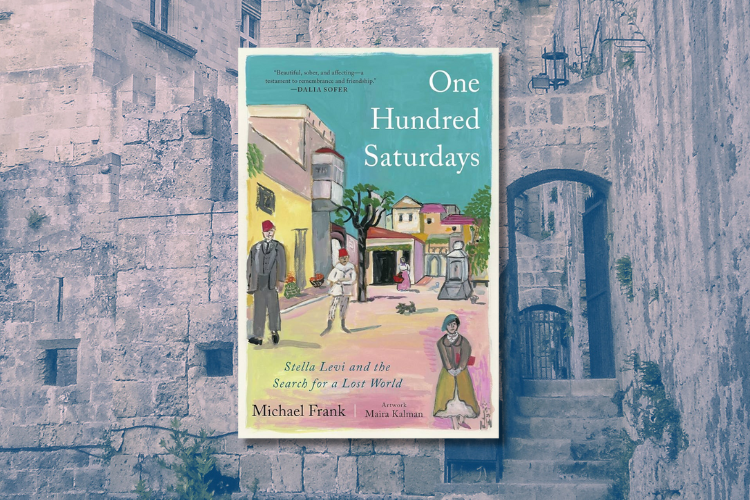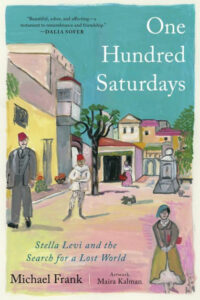
Unearthing One Woman’s Past in Jewish Rhodes
With nearly a century of life behind her, Stella Levi had never before spoken in detail about her past. Then she met Michael Frank. He came to her Greenwich Village apartment one Saturday afternoon to ask her a question about the Juderia, the neighborhood in Rhodes where she’d grown up in a Jewish community that had thrived there for half a millennium.
Neither of them could know this was the first of one hundred Saturdays that they would spend in each other’s company as Stella traveled back in time to conjure what it felt like to come of age on this luminous, legendary island in the eastern Aegean, which the Italians began governing as an official possession in 1923 and transformed over the next two decades until the Germans seized control and deported the entire Juderia to Auschwitz. The result of these conversations is One Hundred Saturdays (Simon & Schuster, $28.00) and author Michael Frank talks to Fiction Editor Yona Zeldis McDonough about this magical modern-day Scheherazade.
YZM: When did you realize that your meetings with Stella Levi would eventually become a book?
MF: More than a year! This might sound strange, but quite honestly I had no idea that I might write about Stella when I first went to speak to her. I was simply curious about her story—curious about her. She is deeply captivating, a great natural storyteller who is gifted with a remarkable and long memory, made even longer by having been the seventh-born child in her family. It was as if all the family stories ended up in her lap—and brain. Stella’s connection to what Henry James called the “visitable past” –the past that you can see and feel, almost touch—reaches back well into the nineteenth-century, when her grandmothers were born. The more I listened, the more I thought that Stella’s story felt like a natural book. The question then became how to write it.
YZM: What about her story made you feel it could exist on a wider canvas?
MF: Stella had a tragic encounter with one of the major cataclysms of the twentieth century when her entire community was deported to Auschwitz in July of 1944; it’s hard to imagine a wider canvas than that. But the truth is that, as important to me, was capturing the world Stella was born into and grew up in. As one of the few people alive today who lived and breathed daily life in Jewish Rhodes, she is an encyclopedia of information about, well, just about everything: music, food, culture, clothes, language, superstitions, beliefs, dreams. The vividness of the particular explored in a wider sociological and historical context is, to my mind, what is special about Stella’s story.
YZM: Did the nature of your conversations change over time? How and why did this happen?
MF: It took Stella a considerable amount of time to trust me, to get to know me, and for me to come to know her—for us to know each other. At first my questions were, I see now, too pointed, maybe too direct. Gradually I learned to let Stella feel her way through her descriptions of a moment, a friendship, a conflict, a secret. The more we talked, the more open she became.
One of the more frustrating parts of listening to the story of someone’s life, I eventually discovered, is not knowing what to ask. Now and then, especially in the later years, Stella would say, “I know I told you about…” and then she would add an incredible detail or revelation. I would get mad at her—fake, affectionate mad: “You’ve been holding out on me again?” And she would laugh. I think she might have done it intentionally— it was her way of drawing me back, week after week, year after year.
YZM: Tell me a little about the history of Juderia? Does it still exist?
MF: The Juderia of Rhodes was the neighborhood on the island within the old walled city where this Sephardic Jewish community lived for at least half a millennium, after they were expelled from Spain in 1492, though there were other Jews on Rhodes reaching farther back in time. The Juderia was never a ghetto. There were no gates and locks and only intermittently laws regulating Jewish life; in fact the Jews lived under the Ottomans in relative peace (with of course some exceptions) alongside their Turkish and Greek neighbors.
In the Juderia, private life was also quite public: many houses were built around courtyards, and doors were left open for children to come and go as they pleased. Singing, music, news, gossip, the scent of delicious food being prepared flowed through these doors and windows and along these cobbled streets. It was a homogenous world that was also, for the younger generation, quite porous. On the one had you had Stella’s paternal grandmother who, to Stella’s knowledge, never left the neighborhood—as why would she, with the synagogue next door, her family and friends everywhere nearby? On the other hand you had Stella, her siblings, and her friends, who were attracted by the wider world introduced by the Italians after they took official colonial possession of the island in 1923 and introduced cinema, opera, Italian music, secular education, and a more varied social life.
After the war, virtually no member of the Jewish community returned to live in the Juderia. What remains today are buildings, some still in ruins after being bombed by the British during the war. One synagogue, the Kahal Shalom, which stood across the street from Stella’s house, has been beautifully restored and has a museum that tells the story of the community. But the Juderia of Stella’s youth is definitively gone.

YZM: Let’s talk about using Maira Kalman’s artwork to illustrate the story—how did that come about?
MF: Maira heard about Stella’s story and offered to illustrate the book. I liked the idea of using paintings instead of photographs, because I felt they were in line with what the book was doing: in the writing I am telling the story of how I came to hear, and retell, the story of this unforgettable woman, and any retelling is, by its nature, a kind of reinterpretation. Maira’s paintings do something similar; they revisit rather than, like photographs, represent. They also, I think, do a splendid job of evoking the color, vibrancy, and sensuality of daily life on the island in a way that Maira grasped intuitively.
YZM: Levi’s story includes the stories of several remarkable Jewish women—can you elaborate?
MF: The matrilineal life force was very strong indeed in the Juderia. Stella’s maternal grandmother, Sara Notrica, was one of several healers in the community whose folk cures, superstitions, beliefs, and human insights healed and guided many people across many generations. Stella’s mother Miriam was a surprisingly open-minded woman for her time: she set a lifelong example of openness and acceptance by refusing to gossip, or judge, or criticize other people—more than once she said to Stella, “No one who has a daughter of her own should speak ill of a young woman’s behavior.” Then there was her brainy, bookish, free-thinking older sister Felicie, who questioned the existence of God, criticized the Fascist regime under which they all lived, took Stella to see the Greek ruins the Italians were excavating in order to show her that they belonged to a place with a significant history beyond the Juderia, and stayed up deep into the night talking ideas with her friends. Each in her way marked and formed the young Stella.
YZM: What do you hope readers will take away from this book?
MF: That they should ask all the older people they know and care for every question they can think of—right away.



